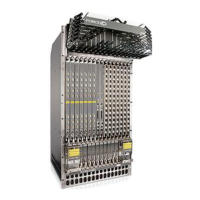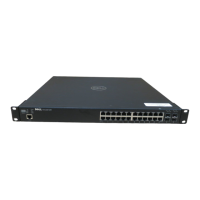474 | Link Aggregation Control Protocol (LACP)
www.dell.com | support.dell.com
Shared LAG State Tracking
Shared LAG State Tracking provides the flexibility to bring down a port channel (LAG) based on the
operational state of another LAG. At any time, only two LAGs can be a part of a group such that the fate
(status) of one LAG depends on the other LAG.
In Figure 22-5, line-rate traffic from R1 destined for R4 follows the lowest-cost route via R2, as shown.
Traffic is equally distributed between LAGs 1 and 2. If LAG 1 fails, all traffic from R1 to R4 flows across
LAG 2 only. This condition over-subscribes the link, and packets are dropped.
Figure 22-5. LAGs using ECMP without Shared LAG State Tracking
To avoid packet loss, traffic must be re-directed through the next lowest-cost link (R3 to R4). FTOS has the
ability to bring LAG 2 down in the event that LAG 1 fails, so that traffic can be re-directed, as described.
This is what is meant by Shared LAG State Tracking. To achieve this functionality, you must group LAG 1
and LAG 2 into a single entity, called a failover group.
Configure Shared LAG State Tracking
To configure Shared LAG State Tracking, you configure a failover group:
Step Task Command Command Mode
1
Enter port-channel failover group mode.
port-channel failover-group
CONFIGURATION
2
Create a failover group and specify the
two port-channels that will be members
of the group.
group number port-channel
number port-channel
number
CONFIG-PO-FAILOVER-GRP
Po 1
Po 2
fnC0049mp
R1
R2 R3
R4
Po 1 failure
Po 2 over-subscribed

